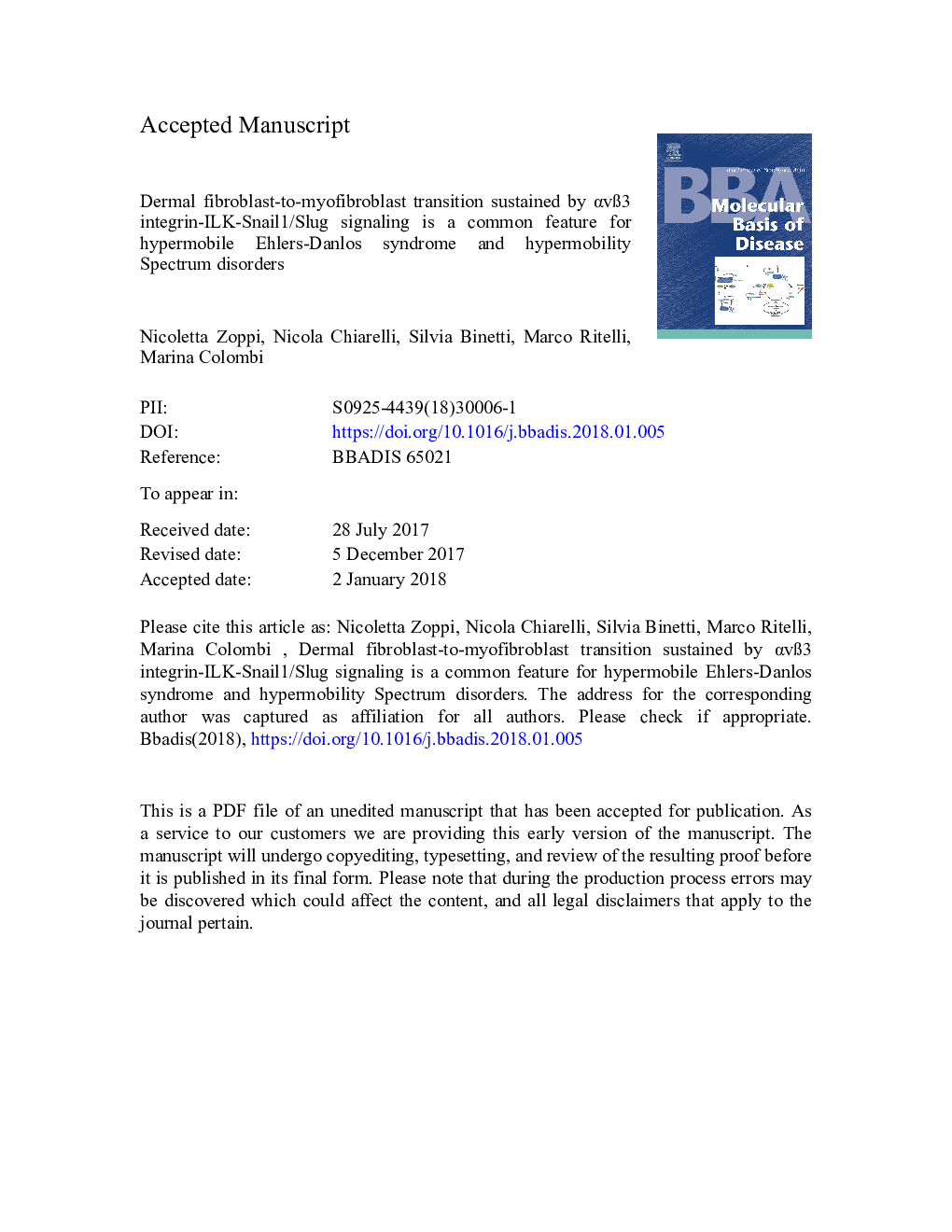| کد مقاله | کد نشریه | سال انتشار | مقاله انگلیسی | نسخه تمام متن |
|---|---|---|---|---|
| 8258565 | 1534610 | 2018 | 45 صفحه PDF | دانلود رایگان |
عنوان انگلیسی مقاله ISI
Dermal fibroblast-to-myofibroblast transition sustained by αvÃ3 integrin-ILK-Snail1/Slug signaling is a common feature for hypermobile Ehlers-Danlos syndrome and hypermobility spectrum disorders
دانلود مقاله + سفارش ترجمه
دانلود مقاله ISI انگلیسی
رایگان برای ایرانیان
کلمات کلیدی
DAMPsHSDPFAHRPJHSEDSCIDqPCRmAbR.T.o.n.MMPα-SMAECMαvβ3 integrin - αvβ3 انتگرالMonoclonal antibody - آنتی بادی مونوکلونالPolyclonal antibody - آنتی بادی های پلی کلونالILK - اولα-smooth muscle actin - اکتین عضله آلفا صافover night - بیش از شبGeneralized joint hypermobility - حرکات متحرک مفصلstandard error of mean - خطای استاندارد میانگینRoom temperature - دمای اتاقHEDs - زیباییEhlers-Danlos syndrome - سندرم Ehlers-DanlosJoint hypermobility syndrome - سندرم هیپر جابجایی مشترکConditioned medium - شرایط محیطیFibronectin - فیبرونکتینExtracellular matrix - ماتریکس خارج سلولیmatrix metalloproteinase - ماتریکس متالوپروتئینازMEM - مامانSEM - مدل معادلات ساختاری / میکروسکوپ الکترونی روبشیImmunofluorescence microscopy - میکروسکوپ ایمونوفلورسانسType III collagen - نوع III کلاژنType V collagen - نوع کلاژن Vquantitative real-time polymerase chain reaction - واکنش زنجیره ای پلیمراز کمی زمان واقعی استWestern blotting - وسترن بلاتینگparaformaldehyde - پارافرمالدهیدHorseradish peroxidase - پراکسیداز هوررادیشintegrin linked kinase - پیوند کیناز انتگرالcollagens - کولاژن ها
موضوعات مرتبط
علوم زیستی و بیوفناوری
بیوشیمی، ژنتیک و زیست شناسی مولکولی
سالمندی
پیش نمایش صفحه اول مقاله

چکیده انگلیسی
Hypermobile Ehlers-Danlos syndrome (hEDS) is a heritable connective tissue disorder with unknown molecular basis mainly characterized by generalized joint hypermobility, joint instability complications, and minor skin changes. The phenotypic spectrum is broad and includes multiple associated symptoms shared with chronic inflammatory systemic diseases. The stricter criteria defined in the 2017 EDS nosology leave without an identity many individuals with symptomatic joint hypermobility and/or features of hEDS; for these patients, the term Hypermobility Spectrum Disorders (HSD) was introduced. We previously reported that in vitro cultured hEDS and HSD patients' skin fibroblasts show a disarray of several extracellular matrix (ECM) components and dysregulated expression of genes involved in connective tissue homeostasis and inflammatory/pain/immune responses. Herein, we report that hEDS and HSD skin fibroblasts exhibit in vitro a similar myofibroblast-like phenotype characterized by the organization of α-smooth muscle actin cytoskeleton, expression of OB-cadherin/cadherin-11, enhanced migratory capability associated with augmented levels of the ECM-degrading metalloproteinase-9, and altered expression of the inflammation mediators CCN1/CYR61 and CCN2/CTGF. We demonstrate that in hEDS and HSD cells this fibroblast-to-myofibroblast transition is triggered by a signal transduction pathway that involves αvβ3 integrin-ILK complexes, organized in focal adhesions, and the Snail1/Slug transcription factor, thus providing insights into the molecular mechanisms related to the pathophysiology of these protean disorders. The indistinguishable phenotype identified in hEDS and HSD cells resembles an inflammatory-like condition, which correlates well with the systemic phenotype of patients, and suggests that these multisystemic disorders might be part of a phenotypic continuum rather than representing distinct clinical entities.
ناشر
Database: Elsevier - ScienceDirect (ساینس دایرکت)
Journal: Biochimica et Biophysica Acta (BBA) - Molecular Basis of Disease - Volume 1864, Issue 4, Part A, April 2018, Pages 1010-1023
Journal: Biochimica et Biophysica Acta (BBA) - Molecular Basis of Disease - Volume 1864, Issue 4, Part A, April 2018, Pages 1010-1023
نویسندگان
Nicoletta Zoppi, Nicola Chiarelli, Silvia Binetti, Marco Ritelli, Marina Colombi,